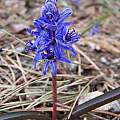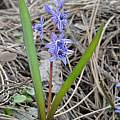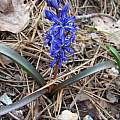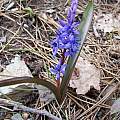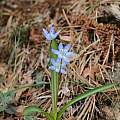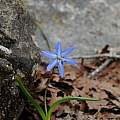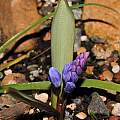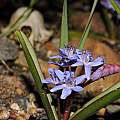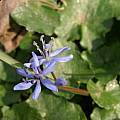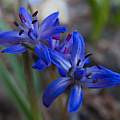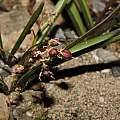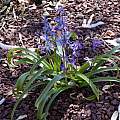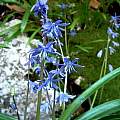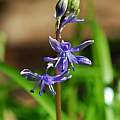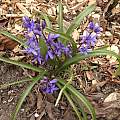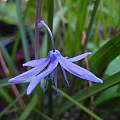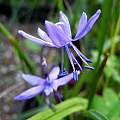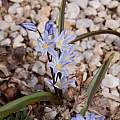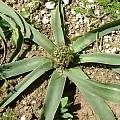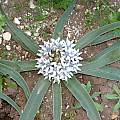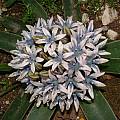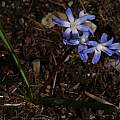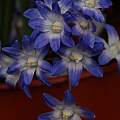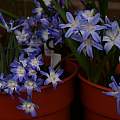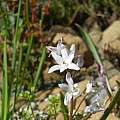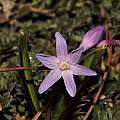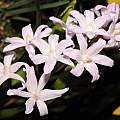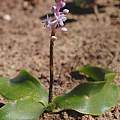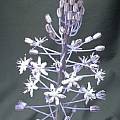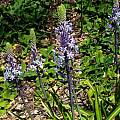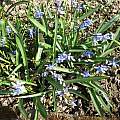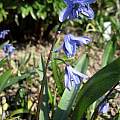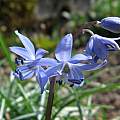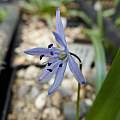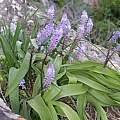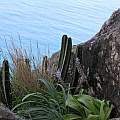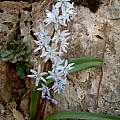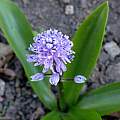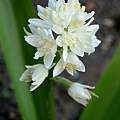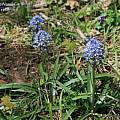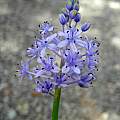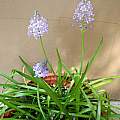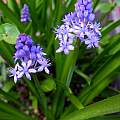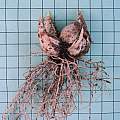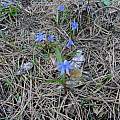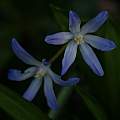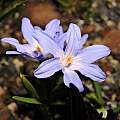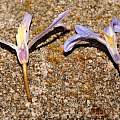Scilla is a large genus in the Hyacinthaceae family (or most recently in the subfamily Scilloideae under the umbrella of the Asparagaceae) with most species found in Europe, North Africa and western to central Africa. There are also species from tropical Africa, India, and South Africa. Some are winter growing and some are summer growing. Species a-l are found on this page.
Scilla albinervis Yildirim & Gemici is native to a small area near the center of southern Turkey. It has pinkish bulb scales, a white midrib on the tepals, and yellowish or orange seeds with a white elaiosome. Height: 10-15 cm. It is closely related to Scilla bifolia. The species was described by Hasan Yildirim (epublished September 2014), who also shared the following photos.
Scilla arsusiana Yildirim & Gemici is similar to Scilla melaina and Scilla ingridiae, and is native to a similar region in southern Turkey. It grows on forested serpentine slopes. The seed morphology and flower diagnostics were used to distinguish the species. It was described by Hasan Yildirim (epublished September 2014), who also shared the following photos.
Scilla autumnalis L. see Prospero autumnale(L.) Speta
Scilla bifolia L., widespread in central and southern Europe, the Caucasus and Asia Minor, is an old garden plant. It's an early bloomer and shows color almost as soon as the sprouts break ground. Although eclipsed by some of its relatives in both size and intensity of color, it nevertheless makes an appreciated presence in the early garden. In many areas, it self-sows unobtrusively, in other areas perhaps not so unobtrusively. Height: 7-15 cm. In the break-up of the genus Scilla in the broad sense as presented in Julian Slade's discussion, Scilla bifolia remains a member of the genus Scilla. The first two photos by Travis Owen show the buds, which appear lavender and fade to blue as they prepare to open. The third photo shows a form, photographed by Jim McKenney in his Montgomery County, Maryland, USA garden, of a self-sown seedling from commercial stock acquired decades ago. Photo four is of a form from Northern Greece by Rimmer de Vries. Final photo by Travis Owen shows swelling seed pods, similar to Chionodoxa seed pods but smaller.
Scilla cilicica Siehe is native to southern Turkey, Syria, Lebanon, and northern Israel. It grows in scrub, under bushes, and in rocky places. Leaves appear in the fall and the lilac blue slightly-reflexed flowers winter into spring. Height range: to 50 cm. First photo taken by John Lonsdale; photos 2 and 3 taken in its natural habitat in north Israel by Oron Peri. Photo 4 by Rimmer de Vries of a plant ex RRW96.28 from Jebel Nusairia, Syria; he comments it was hardy outside in garden winter of 2013-14 in SE Michigan. The last two photos from Mary Sue Ittner.
Scilla cretica (Boiss. & Heldr.) Speta is endemic to Crete where it grows in scrub at 1300-1700 m. Height range: 10-20 cm. Photo by John Lonsdale.
Scilla cupanii Guss. see Scilla peruviana L.
Scilla dimartinoi Brullo & Pavone is a beautiful yet little known species endemic from Lampedusa, a small island between Sicily and North Africa. This proposed name change for this species was Oncostema dimartinoi in the genus Oncostema. It is very distinctive and can't be confused with the closely related Scilla peruviana and Scilla hughii. It bears similarities with some South African plants. The dull green leaves lay flat on the ground in a starfish fashion, like many Brunsvigia and have hairy margins like some Haemanthus. The long bracts have hairy margins as well. The inflorescence is a practically stemless umbel of densely packed flowers, reminiscent of a giant Massonia. Flowers are nearly white with a very pale blue shade, giving the feeling of grayish flowers, but pistils are darker. Those in photos are young plants seed raised, at their very first flowering and the inflorescence is about 10 cm across, but the species can grow as large as Scilla peruviana with bulbs half exposed. The last picture is a close-up of the flowers. Ants seem to be the pollinators, as they were visiting the flowers, which secrete droplets of nectar. Photos and text by Angelo Porcelli.
Scilla dracomontana Hilliard & B.L.Burtt see Merwilla dracomontana (Hilliard & B.L.Burtt) Speta
Scilla greilhuberi Speta see Fessia greilhuberi (Speta) Speta
Scilla forbesii (Baker) Speta, syn. Chionodoxa forbesii Baker, Chionodoxa siehei Stapf, is from the West of Turkey. The flowers of Scilla forbesii are most often smaller than those of Scilla luciliae, with slightly more pointed tepals. The filaments and anthers are typically even in length, the filaments are wide at the base, tapering to a point. Flowers number around 4 to 10 per inflorescence, erect to spreading, with stems growing six to twelve inches (15–30 cm) tall. White, blue, and pink forms are often sold in mixes or under names such as 'Pink Giant' or 'Blue Giant', though these may actually be forms of C. luciliae or hybrids. Photos by David Pilling, the third one shows what was known as C. forbesii (left) and C. luciliae.
Photos by Travis Owen show different forms sold as "Chionodoxa luciliae", now all considered to be Scilla forbesii.
Scilla haemorrhoidalis Webb & Berthel., syn. Autonoe haemorrhoidalis (Webb & Berthel.) is from the Canary Islands. In 2025 World Flora Online lists it as an accepted species and Plants of the World Online as a synonym of Autonoe haemorrhoidalis. It blooms in late winter in shades of pink, mauve and blue. The name which may mean 'blood red', 'bleeding' or 'veins' may refer to the red stems. The three leaves are wide and fleshy. Photo taken by Oron Peri of a plant in his collection.
Scilla hohenackeri Fisch. & C.A.Mey. see Fessia hohenackeri (Fisch. & C.A.Mey.) Speta
Scilla hughii Tineo ex Guss. see Scilla peruviana L.
Scilla hyacinthoides L. is a Mediterranean species, originally from Middle East but naturalized here and there in South of Italy. It needs a poor stony soil to flower well, otherwise it will develop an abnormal number of offsets missing the flowering. It was proposed to be moved into a new genus with it as the sole species, Nectaroscilla hyacinthoides (L.) Parl, but this change in 2021 has not been accepted. First photo by Angelo Porcelli second and third photo taken at the UC Botanical Garden by Nhu Nguyen of a clone from Israel.
Scilla ingridiae Speta from southern Turkey is similar to Scilla siberica with one to three pale blue flowers. It differs in its seeds that do not have a fleshy appendage. Photos from Hans Joschko.
Scilla ingridiae var. taurica (Barr) Speta is not differentiated from the species in 2025. The photo by Rimmer de Vries is of plants grown from seed (RRW93.33) collected in Adana province, Turkey.
Scilla japonica Baker see Barnardia japonica (Thunb.) Schult. & Schult.f.
Scilla latifolia Willd. ex Schult.f, syn. Autonoe latifolia (Willd. ex Schult.f.) Speta, is native to the Canary Islands, Morocco, and the Western Sahara. In 2025 World Flora Online lists it as an accepted species and Plants of the World Online as a synonym of Autonoe latifolia. It is a robust plant, with a bulb up to 6 cm in diameter and 3-6 lanceolate leaves up to 8 cm wide and 40 cm long and inflorescences with numerous blue-lilac flowers. It grows from 35 to 50 cm high. Photos from iNaturalist were taken by sebsant January 2008 in Ténérife, Canary Islands and shared under a CC BY-NC license.
Scilla libanotica Speta is a rare species distributed in Lebanon, W. Syria and in one location on the Israeli side of Mt. Hermon. Unlike its closely related S. cilicica, Scilla libanotica appears and flower just days after snow melts. It grows in shaded rocky habitats and at the base of deciduous trees. Photo taken in its habitat by Oron Peri.
Scilla lilio-hyacinthus L. has a bulb that mimics somehow the scaly structure of a lily bulb. Planted in the foreground of a sunny border with very rich soil in Oregon in Jane McGary's garden it increased vigorously. It was proposed to be included in the new genus Tractema. Pictures show a blue and a white flowered specimen grown by Martin Bohnet.
Scilla lingulata Poir. see Hyacinthoides lingulata (Poir.) Rothm.
Scilla litardierei Breistr. (syn. Scilla amethystina, Scilla pratensis, Scilla albanica, Scilla italica and Scilla nutans) was proposed in 2009 to be renamed Nectaroscilla littardierei (Breistr.) Trávníèek, but in 2021 this has not been accepted. See Trávníèek et al. 2009 for the paper proposing the name change. It is commonly known as the Amethyst Meadow Squill (or Dalmatian Scilla) and is from the western Balkans. Judy Glattstein sent the first picture below to the Mystery Bulbs page of the wiki saying "I was foraging just across the Delaware River in Bucks County, Pennsylvania and found this bulb growing near a boarded up house for sale. There were several, some with multiple stems and some non-flowering - don't know - seedlings? The only thing it looks like to me is Scilla peruviana and I doubt that that would be winter hardy here". For more see her web page. PBS list members soon identified the bulb. See list archive. The rest of the photos are from Mary Sue Ittner. The last shows the bulbs on a 1 cm grid.
Scilla lochiae (Meikle) Speta, syn. Chionodoxa lochiae Meikle, is endemic to Cyprus. The flowers, like Scilla sardensis, have no white at the base of the petals (except for the bases of the filaments), but are described as nodding. Height: about 15 cm. The photo from iNaturalist was taken by Grzegorz Grzejszczak in March in Cyprus and shared under a CC BY-SA license.
Scilla luciliae (Boiss.) Speta, syn. Chionodoxa luciliae Boiss., is a free spreading early spring small bulb that is known as Glory of the Snow. It is native of Western Turkey near Izmir. It has 2 to 3 violet-blue flowers in a loose raceme that are white at the base of the tepals with white filaments. The flowers of Scilla lucileae are slightly larger than those of Scilla forbesii, with somewhat more parallel tepal margins. The filaments are most often uneven in length with parallel (sometimes barely tapered) margins. The anthers are equal in length, but will appear uneven due to the differing lengths of the filaments. The inflorescence is erect to ascending on stems four to eight inches (10-20 cm) tall. Sometimes it is sold in pink and white forms, possibly hybrids. Flowers are upward facing, about 3.5 cm. wide. First three photos by John Lonsdale and David Pilling. Remaining photos by Travis Owen. Photo 4 shows a close up of a flower, photo 5 shows dissected flowers showing the differing lengths of the filaments.
